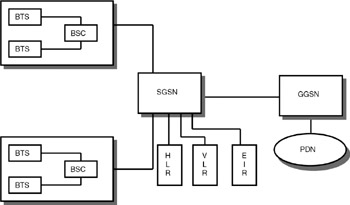33.5 2.5G WIRELESS NETWORKS
|
| < Day Day Up > |
|
33.5 2.5G WIRELESS NETWORKS
The 2.5 generation wireless networks evolve from 2G wireless networks to support data rates in the range 64-144 kbps. HSCSD and GPRS networks are 2.5G networks that evolve from GSM networks to support high data rates.
High-speed circuit switched data (HSCSD): In a GSM network, when a call is established using a circuit switched operation, one time slot is allocated to the handset. In one time slot, we can push 14.4kbps data using efficient coding techniques. If four consecutive time slots are allocated for a user, it gives 57.6kbps end-to-end connection. As shown in Figure 33.7, the MSC of the GSM network has to be interfaced with the PSTN or Internet through an inter working function (IWF) to access Internet services. The IWF carries out the necessary protocol conversion. Using this approach, download speeds up to 43.2kbps have been achieved. This data rate is sufficient to support services such as audio streaming and high-resolution graphics and animation.

Figure 33.7: GSM circuit-switched data service.
General packet radio service (GPRS): GPRS is a packet architecture that overlays existing GSM infrastructure. Using eight time slots simultaneously, data rates up to 172kbps can be achieved with GPRS. GPRS employs variable rate coding schemes and multislot operation to increase data rates. Four possible coding systems corresponding to data rates of 9.05, 13.4, 15.6 and 21.4kbps in each slot have been recommended in the GPRS standard. GPRS is more efficient than HSCSD in spectrum utilization and is seen as the best route to 3G. Video transmission using the MPEG-4 standard has been demonstrated over the GPRS network.
High-speed circuit switched data (HSCSD) service is offered on the existing GSM networks by allocating multiple time slots to a user. Data rates up to 57.6kbps can be achieved using this approach.
The block diagram of a GPRS system is shown in Figure 33.8. Gateway GPRS support node (GGSN) is the gateway between a GPRS wireless network and the IP-based data network. GGSN carries out the necessary protocol conversion and address conversion. Serving GPRS support node (SGSN) routes and delivers the packet data between GGSN and the appropriate BSS of the GSM network. The functions of SGSN are:
-
Packet routing and transfer
-
Mobility management
-
Logical link management
-
Authentication
-
Billing

Figure 33.8: GPRS architecture.
The GPRS system offers packet switching services. The elements of GPRS network are Gateway GPRS support node (GGSN) and serving GPRS support node (SGSN), in addition to the standard GSM network elements.
The location register of SGSN stores location information (current cell, current VLR) and the user profile of the subscriber registered with the SGSN.
Many versions of wireless networks based on CDMA are operational in the U.S., China, and Korea. Qualcomm is the pioneer in CDMA technology.
CDMA-based wireless Internet: The early cellular systems were based on analog technology. Subsequently, digital technologies were used: In the U.S., the IS-136 standards-based systems and in Europe, GSM systems. However, both these technologies are based on TDMA as the multiple access technique. In the 1990s, the commercial viability of CDMA technology was demonstrated. CDMA was extensively used in defense systems but not for civilian communications. Led by Qualcomm Corporation, a pioneer in CDMA technology, many companies in China, Korea and elsewhere also developed CDMA-based systems for wireless communications. CDMA 2000-1x is the standard for 2.5G systems based on CDMA.
|
| < Day Day Up > |
|
EAN: 2147483647
Pages: 313